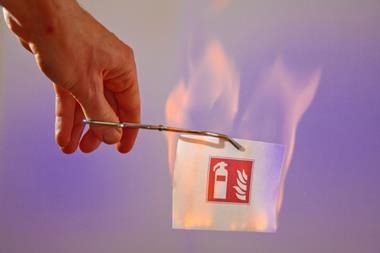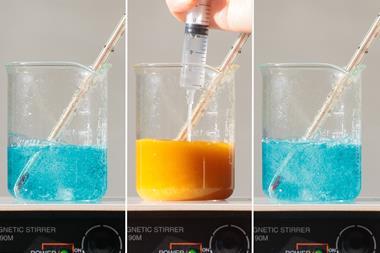Watch the video and download technicians notes from the Education in Chemistry website: rsc.li/EiC417ec
Le Chatelier’s principle (LCP) and the concept of equilibrium are tricky topics for many students, and LCP is still present in many exam specifications. But don’t worry – just go outside and throw some water around.
Kit
- 50 cm3 measuring cylinder
- Five boiling tubes and rack
- Two 250 or 500 cm3 beakers for use as water baths
- Cobalt(II) chloride hexahydrate, 2 g (toxic, dangerous for the environment)
- Concentrated hydrochloric acid, 100 cm3 (corrosive)
- Crushed ice (approx. 200 cm3) and a kettle
Optional extra: two large buckets or washing up bowls half filled with water, two large plastic beakers (250 or 500 cm3) and a much smaller plastic beaker (50 or 100 cm3).
Preparation
Prepare an approximately 0.4 M solution of cobalt chloride by dissolving the powder in 20 cm3 of deionised water, then top it up to 50 cm3 with concentrated hydrochloric acid. It should be violet. Adding more acid will make it appear more blue, adding more water will make it more pink – adjust the solution until you have an intermediate violet and divide the solution equally among the five boiling tubes. The central tube will be a control for comparison.
Immediately before the demonstration, prepare a beaker of ice water and another of boiled water.
In front of the class
Usually before I do this demonstration, I take the students outside with two buckets half-filled with water and some plastic beakers. Although I don’t initially point this out to them, one bucket is labelled ‘red’ and one is labelled ‘blue’. I pick two students, assign each a bucket and hand them plastic beakers of the same size.
Placing the buckets a few metres apart, I tell them that each one will have to fill the other’s bucket. I invite the class to predict what’s going to happen to the levels of liquid in each – most of the time they predict that both buckets will remain exactly as they are but in the hurry some water will be lost.
This demonstration allows students to see the meaning of the words dynamic and equilibrium, as well as the importance of having a closed system in which the equilibrium can be set up.
Often one student is faster than the other and the level of liquid in one bucket drops to the point that it becomes difficult for the faster student to fill their beaker in one scoop. Meanwhile the other student is able to quickly dunk theirs and pass across a full beaker. This lets students see how an equilibrium can be arrived at as the rates of forward and backward reactions converge.
At this point I show the students the labels on the buckets and tell them that the level of each liquid can represent the amount of a blue chemical and a red chemical in a mixture. They are able to predict that the mixture overall will have a purple appearance when there is roughly half of each chemical present.
Next, I change the conditions of the equilibrium by swapping one of the big beakers for a far smaller one and ask students to predict the effect on the levels of the liquids and the resulting colour. Again, a new equilibrium is reached as the smaller beaker is quickly filled but the large beaker can only be slightly filled in a nearly-empty bucket.
The demonstration
We return inside to see the effect on equilibrium between the ‘red chemical’ – [Co(H2O)6]2+ – and the ‘blue chemical’ – [CoCl4]2– – and I show them the equation for the reaction.
[Co(H2O)6]2+(aq) + 4Cl–(aq) ⇌ [CoCl4]2–(aq) + 6H2O(l)
Students can connect the rates of the forward and backward reactions with the buckets outside. Initially there is a violet mixture, which suggests a roughly equal proportion of the two complexes.
Effect of concentration on equilibrium
Tell students the hydrochloric acid is a source of chloride ions. Invite them to predict the effect of adding chloride ions to the mixture on the rates of the forward and backward reactions.
Add the acid dropwise to one of the boiling tubes. Initially, the additional chloride ions will increase the frequency of collisions on the left side, increasing the rate of production of [CoCl4]2– leading to the solution appearing more blue – in agreement with LCP (see note). The resulting drop in concentration of [Co(H2O)6]2+ will lead to the slowing of this forward rate until the forward and backward rates have once again become the same.
You can show the opposite effect by adding water to another tube.
Effect of temperature on equilibrium
As the forward reaction is endothermic, adding heat to the system by placing a tube in hot water will shift the position of equilibrium right to the endothermic side, resulting in the solution appearing more blue. Add one of the two remaining tubes to the ice bath to see the reverse effect.
Tips
Performing the demonstration in front of a white background can help students to see the colours more easily. Larger containers, such as measuring cylinders or beakers, can be used with a scaled-up version of this demonstration to help larger groups see the effect.
Note
Although LCP does not reliably predict the direction of an equilibrium shift on finite additions of a chemical, exam boards do still typically expect students to respond as if it does.
Safety and disposal
Cobalt(II) chloride may cause an allergic skin reaction, asthma symptoms or breathing difficulties if inhaled. It is suspected of causing genetic defects, may cause cancer by inhalation, may damage fertility, and is very toxic to aquatic life with long lasting effects. Avoid contact with skin and wash your hands after use. To avoid raising dust, weigh the solid on a balance in a fume cupboard that is not switched on and has the sash partially pulled down.
Concentrated hydrochloric acid causes severe skin burns and eye damage. It may cause respiratory irritation. Wear splash-proof goggles.
Do not allow small volumes of solution to dry out – clean glassware immediately and wipe up spills with a damp cloth. All chemicals can be washed down the sink with plenty of water.
Downloads
Technicians notes
Word, Size 52.7 kbTechnicians notes
PDF, Size 46.6 kb




















No comments yet